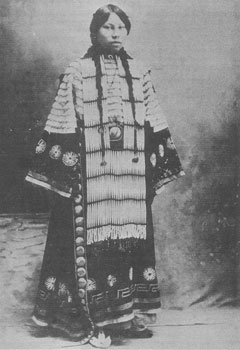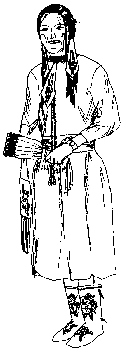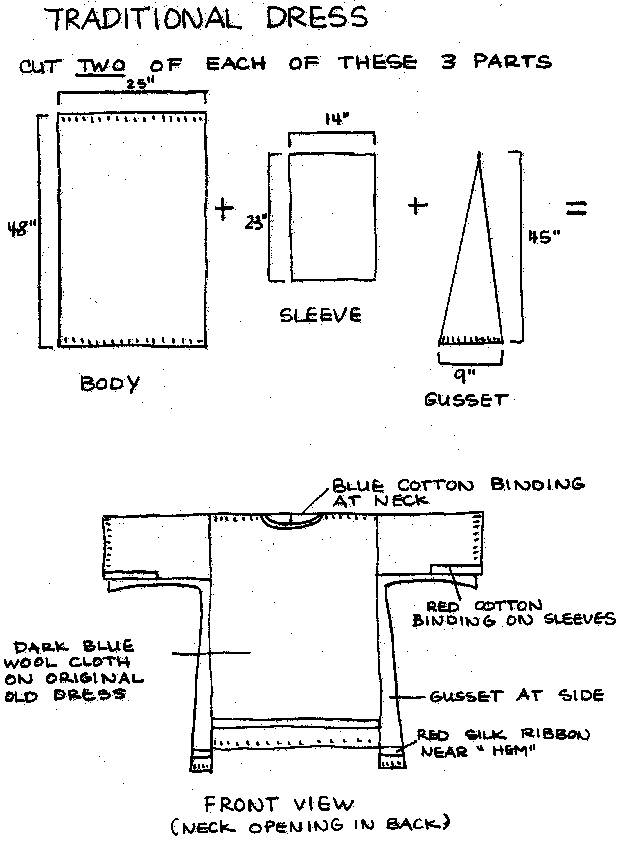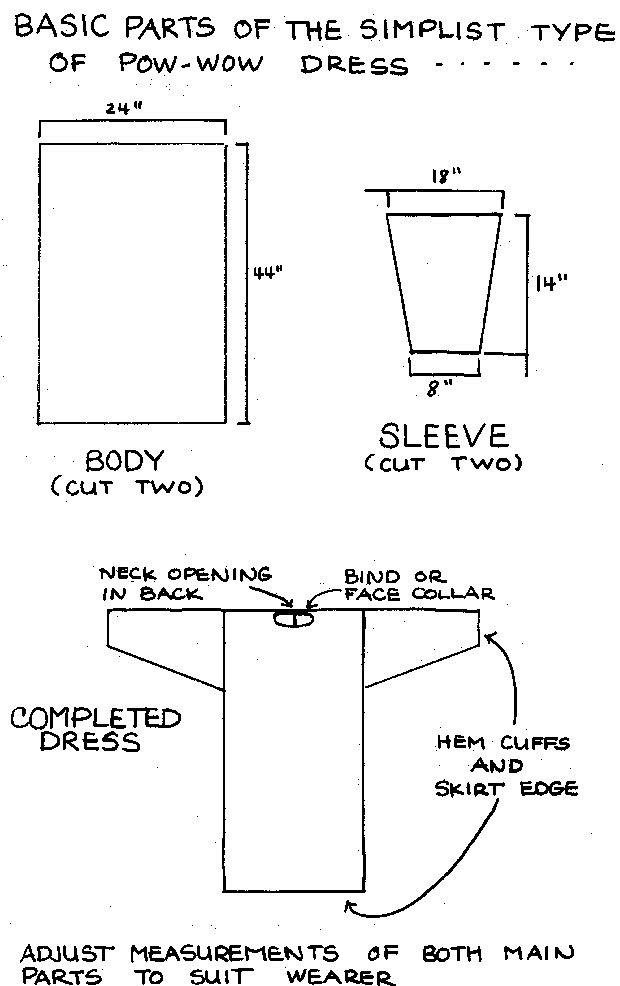
Northern Plains Cloth Dresses
by Rosemary Lessard
originally published as CIHA Indian Craft Series No. 1009
First of all, this isn’t strictly a how-to-do-it article, but rather a descriptive one on a few types of undecorated Northern Plains cloth dresses. It was begun as an addition and complement to Edie Head’s article on Southern Plains (Kiowa and Commanche) taffeta dresses. All the basic dresses herein described can be made in a day -- but remember “Undecorated” is a relative term, and ribbon or binding or even a little beadwork may be necessary to complete a dress. But you don’t need three kilo of size 4/0 beads or 800 elk teeth, or a gallon of dentalia to make any one of these dresses -- may this simplicity of design bring hope to female Indianists everywhere. And, if you want to spend more time and money later on, two of these types of dresses may be elaborated into a more formal costume.
These four types of simple cloth dresses seem to be poorly represented in museum collections, and I believe that no specimens of the modern Northern Plains pow-wow dresses have been collected by museums. So, although you may not have the opportunity to handle and examine one of these dresses, they do (and did) exist, and examples of all these garments can be found in photographs both old and new, many published.

All of these dress styles are appropriate wear at a pow-wow, Indian or White, and are or were worn to dances by Indian women. The three older styles, when undecorated, might also be everyday attire, but accessories were added to dress up for a dance or ceremonial occasion. None of these older types of dresses are used for informal wear nowadays but I have seen the contemporary style as an everyday garment among conservative Crow women -- made from cotton cloth in less bright colors than those used in pow-wow dresses.
SIOUX CLOTH DRESS
This type of dress is well-known, every hobbyists has seen photos of such Sioux dresses decorated with dentalium shells or bone “elk teeth”. Similar dresses without the decoration were also made and worn -- usually as less formal attire, but also to dances and ceremonies. Two woolen dresses and one cotton of this type can be seen in the same McFatridge photo, taken at a dance on the Rosebud Reservation around 1900.
The dress is simple but ingeniously constructed. There are only 5 or 6 main pieces, depending on whether or not there is a shoulder seam in the body of the garment. The main part of the dress is two rectangles of cloth, usually made from the full width of the cloth, selvage to selvage. The sleeves are also simple rectangular pieces of the cloth, and gussets or side-inserts are elongated isosceles triangles. With these straight-sided shapes, a minimum of cloth is wasted. The dress pictured is an old trade-cloth dress owned by my husband and me, and the selveges of the fabric are indicated in the drawings. The dress is long, to the ankles even when belted.
I’ve been thinking about this traditional method of cutting and construction of the Sioux dress, and I believe that the gussets were added probably to increase freedom of movement and perhaps to approximate the shape of the antecedent hide dress. The sleeves, are open at the bottom because the “sleeves” of the old hide dresses also were unsewn there -- and it’s easy to fold the sleeves back and out of the way for messy jobs, or to feed a baby via the large sleeve-opening.
The dark blue, white-edged stroud was the woolen cloth used in making such a dress, and the darker solids and calicos were cotton fabrics used. A woolen dress like this can later be decorated with cowrie shells, dentalia, bone elk teeth- depending upon the owner's s financial situation - to make it into a truly “full-dress” costume.
ACCESSORIES:
- Leggings, beaded in the traditional style.
- Moccasins, with added ankle flaps.
- Belt, tack-studded, concho or plain.
- Shawl or blanket, worn over the shoulders in the usual way for dancing; wrapped about the body in other ways when not dancing. (The long-fringed, lightweight shawl is a modern replacement.)
- Necklaces, braid ornaments, earrings, lowanpi plume (for the eligible only) bracelets (quilled, beaded or metal.)
MODERN POW-WOW DRESS
This dress style is contemporary and can be seen in North and South Dakota, Montana, Saskatchewan -- and probably in Alberta and Wyoming too, although I’ve not yet attended dances in those areas, I call it a “semi-formal” dress because a traditionally styled dress, such as a Sioux dentalium dress or a Crow elk tooth dress, is considered to be “formal” attire, and ordinary store-bought dress is “informal” garb at a pow-wow —- so this especially made dress occupies a middle position in relation to the others. For example, at south Dakota Sioux pow-wows in the summer, when there are dance contests, contestants in the “Traditional” or “old-style” category for women wear old or new skin dresses or trade-cloth dresses, appropriately ornamented. Women dancers entering the “Shawl Dance” or “Women’s Fancy Dance” competitions often wear this “Semi-formal” pow-wow dress. Of course, non-contestants will be seen wearing both of these types of dresses, too.

Taffeta, satin, sateen, brocade, etc. can be used to make a pow-wow dress (shiny fabrics have lately been fashionable) both prints and solid patterns, and all bright colors have been observed. (No very dark or very pale colors have been seen recently.) The dresses are long — sleeved, collarless, with straight (as opposed to gored or pleated) skirts and an opening at the back of the neck.
They’re
street-length with the girls and younger women generally wearing them with
shorter hemlines than the older dancers. No mini-skirts, please! The dress
is a sort of “Pan—Indian” Northern Plains trait, but the accessories and
their decoration are usually in an identifiable tribal art style. But
there’s lots of selling and trading and gift-giving going on, too. So you
may see a Sioux woman wearing Crow-made boot-moccasins, or a Santee Sioux
woman wearing a Cree-made belt, due to these types of intertribal
diffusions.
ACCESSORIES:
- A Shawl, with long fringes, usually worn, not carried over the arm (as
is usual with a wearer of a
Southern Plains taffeta dress.) Beaded braid wraps or ties; beaded hair clips; long ‘hair strings” are typically Sioux. - A beaded headband; the princess crown is seldom seen, though gaining in popularity.
- Necklace (often of the type with a beaded rosette), earrings (usually drop-type)
- Beaded belt. (Crow women wear attractive belt and back-loop- pouch sets)
- Moccasins, Boot-mocs or high-tops have crowded out traditional
footwear in several areas. I’ve never seen old-time Crow mocs worn, and
even the old-time Sioux mocs are giving way to
the popular boot mocs.


Pattern, Child's Cloth Dress
Pattern, Plains Indian Cloth Dress
Pattern, Tradecloth Dress
Pattern, Indian Women's Accessories
3-Band Wool Broadcloth
Copyright © California Indian Hobbyist Association & Rosemary Lessard
Copyright © 2003-2019 Matoska Trading Company Inc